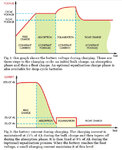abdulwahababid
Member level 3

What will be ratio of voltages between charger and battery in order to charge the battery safely and without reducing the life of battery.
e.g
if the battery is of 12v/10Ah(car battery) then how can I select the voltages of the charger.
I am asking as general. car battery is an example to explain my question.
Charger Voltage should be how much greater than that of battery...!!!!!
any (x)battery, any (?)charger...
charger voltage>how much of battery voltage.
I'm not asking about particularly of car battery. I am talking about general concept of battery and charger
e.g
if the battery is of 12v/10Ah(car battery) then how can I select the voltages of the charger.
I am asking as general. car battery is an example to explain my question.
Charger Voltage should be how much greater than that of battery...!!!!!
any (x)battery, any (?)charger...
charger voltage>how much of battery voltage.
I'm not asking about particularly of car battery. I am talking about general concept of battery and charger
Last edited:





